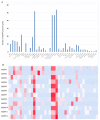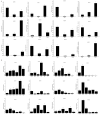Genome-Wide Identification and Analysis of the EPF Gene Family in Sorghum bicolor (L.) Moench
- PMID: 38005809
- PMCID: PMC10674733
- DOI: 10.3390/plants12223912
Genome-Wide Identification and Analysis of the EPF Gene Family in Sorghum bicolor (L.) Moench
Abstract
The EPIDERMAL PATTERNING FACTOR (EPF) plays a crucial role in plant response to abiotic stress. While the EPF has been extensively studied in model plants such as Arabidopsis thaliana, there is a lack of research on identifying EPF genes in the whole sorghum genome and its response to drought stress. In this study, we employed bioinformatics tools to identify 12 EPF members in sorghum. Phylogenetic tree analysis revealed that SbEPFs can be categorized into four branches. Further examination of the gene structure and protein conservation motifs of EPF family members demonstrated the high conservation of the SbEPF sequence. The promoter region of SbEPFs was found to encompass cis-elements responsive to stress and plant hormones. Moreover, real-time fluorescence quantitative results indicated that the SbEPFs have a tissue-specific expression. Under drought stress treatment, most SbEPF members were significantly up-regulated, indicating their potential role in drought response. Our research findings establish a foundation for investigating the function of SbEPFs and offer candidate genes for stress-resistant breeding and enhanced production in sorghum.
Keywords: EPIDERMAL PATTERNING FACTOR (EPF); Sorghum bicolor (L.) Moench; bioinformatics; drought stress.
Conflict of interest statement
The authors declare that they have no conflict of interest.
Figures







References
-
- Mutava R.N. Master Thesis. Kansas State University; Manhattan, KS, USA: 2009. Characterization of Grain Sorghum for Physiological and Yield Traits Associated with Drought Tolerance.
-
- Chadalavada K., Guna K., Kumari B.R., Kumar T.S. Drought stress in sorghum: Impact on grain quality. ScienceDirect. 2022;5:113–134.
Grants and funding
LinkOut - more resources
Full Text Sources

